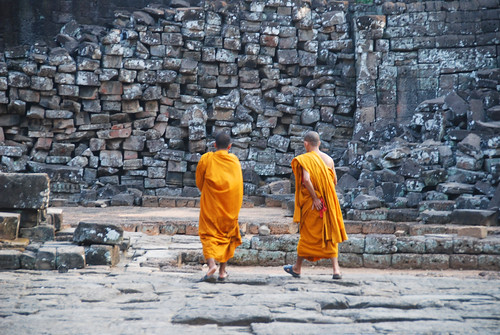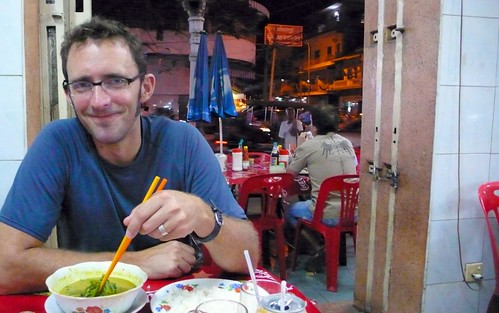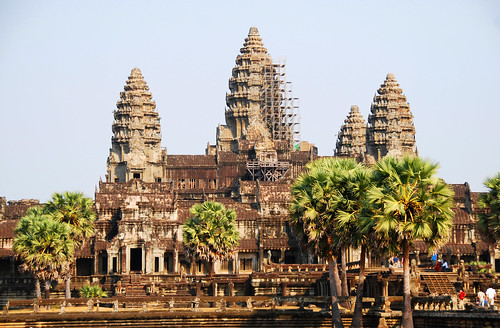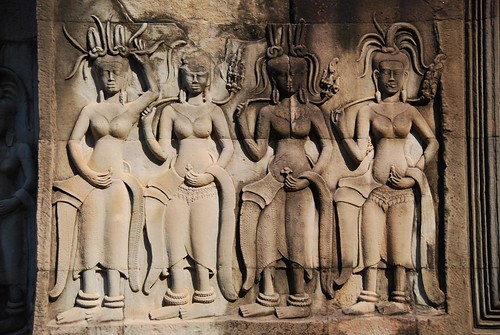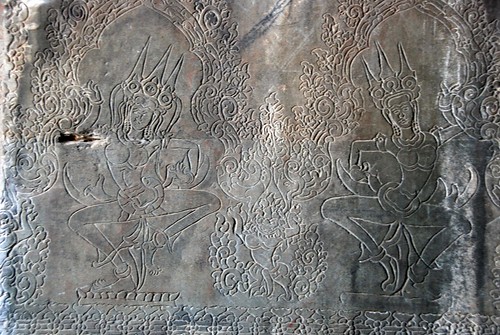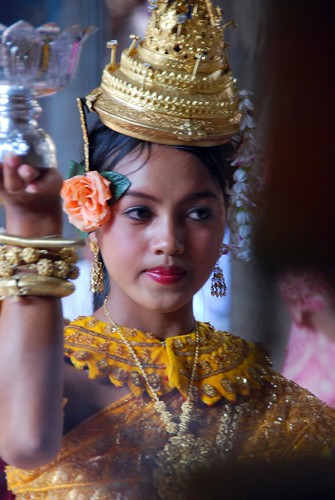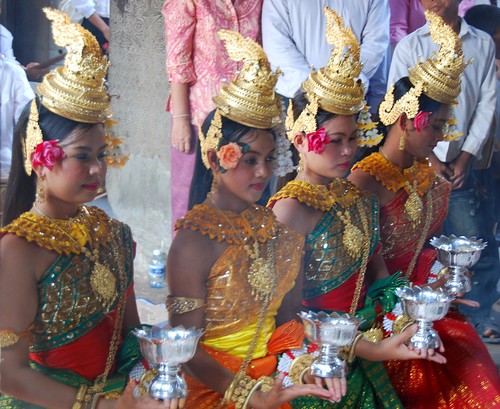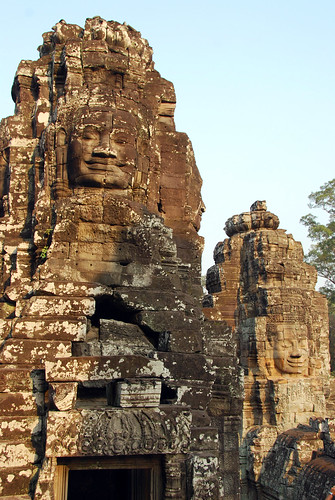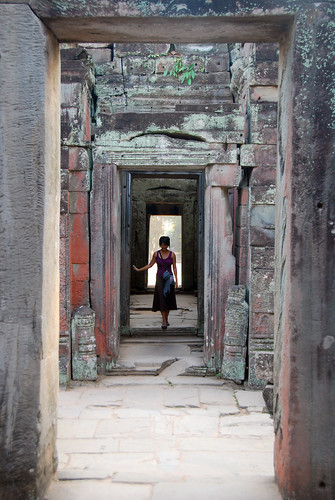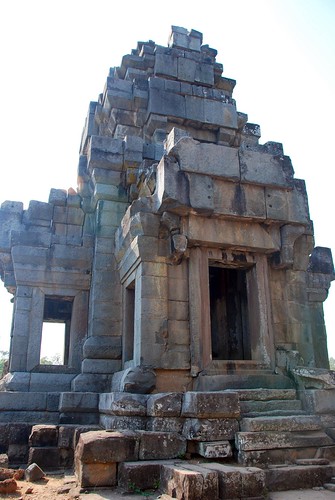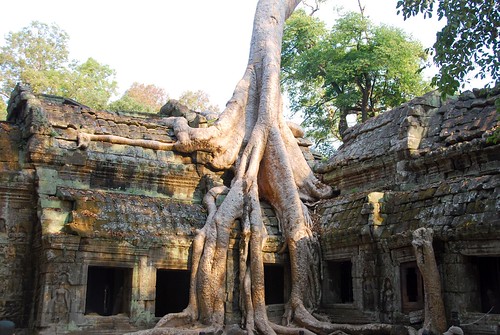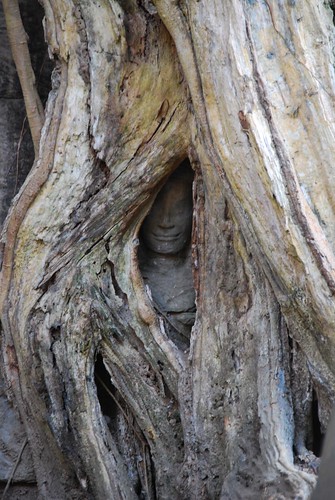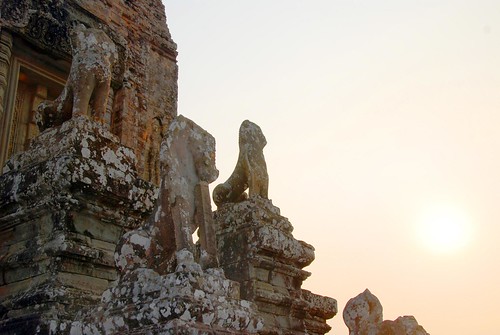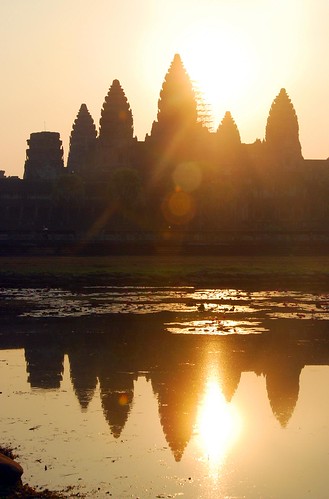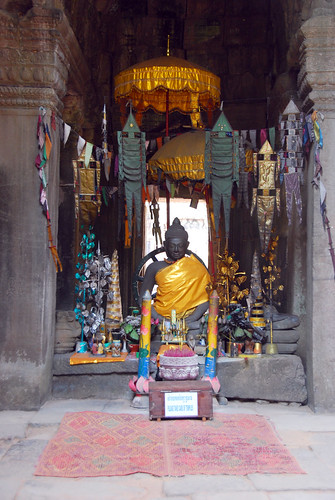Cambodia
Note: If you’re wondering why we did not do wrap-ups for Thailand and Malaysia yet, it’s because we are planning on returning to both countries towards the end of our SE Asia tour.
Days spent here: 7 (February 6-12, 2009)
Prices: We’ve heard a lot of backpackers complain that Cambodia was expensive relative to the rest of SE Asia, and we agree, though we didn’t feel it was outrageously so. In Siem Reap, our hotel (Mandalay Inn) was one of the nicest we stayed in, and one of the cheapest. However, food was on the pricey side (US$3-8 for mains) and the pass to visit Temples of Angkor was definitely expensive (US$40 for a 3-day pass), plus it costs an additional US$12 to hire a tuk-tuk driver to take you into the park (for a full day). In Phnom Penh, our accommodation was moderately priced but not that nice (we paid US$14 for a room without a window)…we got less for our money here. Food was on the spendy side as well.
Places we visited: Siem Reap and the Temples of Angkor, Phnom Penh.
Places we would happily visit again: We LOVED the town of Siem Reap, and the temples just speak for themselves. Even beyond the majesty of Angkor Wat, the town itself was really charming and the people were so nice. Phnom Penh, on the other hand, did not share the same charm; it was sort of a generic SE Asian capital city (in our limited experience of it), and there were a lot of Western tourists, which created a limited set of interactions between foreigners and the local people.
Places we want to see next time: Kratie, where you can see river dolphins, and Sihanoukville, the one big Cambodian beach destination.
Food: Khmer food is good! It has the richness of Thai food but the freshness of Vietnamese food. We sort of tired of it by the end of our visit, but we basically ate Khmer dishes for an entire week so I don’t think that reflects badly on the food. The one standout dish was “green soup” (not terribly descriptive, but that’s what the menu called it), which we had at a food stall in Phnom Penh.
Dust: It’s freakin’ dusty in Siem Reap! When you’re in the back of a tuk-tuk on the way to the temples, do as the locals do and tie a checkered Cambodian scarf around your face to keep out the dust and exhaust. You can buy these for about US$1 at the local markets.
Cambodia wins the “most family members on a motorbike award”: It is VERY common to see an entire family of four or five on a motorbike in Cambodia. The typical configuration is this: oldest child (usually a toddler) in between the driver’s (usually Dad’s) legs, second oldest child wedged between Mom and Dad, and a baby in Mom’s arms. These people grow up on motorbikes so they are very comfortable with the arrangement, though it is very shocking to us safety-conscious Americans.
Check out our Cambodia Flickr album
If southern Thailand was all about relaxation and Malaysia was all about food, then Cambodia is definitely the place of contrasts and extremes. Whereas Siem Reap and the temples of Angkor celebrate Cambodian creativity, spirituality, and diligence, Phnom Penh seems like a city that is trying to move on from the many horrors of the Khmer Rouge and rule under Pol Pot, but is still faced the realities of that dark period every day.
On the bus from Siem Reap to Phnom Penh (more on that adventure later), I was deeply involved in the book First They Killed My Father by Luong Ung, a story of a middle-class Cambodian family that was torn apart during Communist rule. It is a first-hand account of what happened to many people during Pol Pot’s regime: hard labor, starvation, and genocide. Cambodian people of all ages were sent to work in the countryside, growing and harvesting rice, so that Pol Pot’s ridiculous goal of tripling the country’s rice production could be achieved. Field leaders sent off the bulk of their crop for export rather than admit that they could not reach the harvest goal, and the people working in the fields went hungry. There was no medicine, no school—even the family unit was seen as a relic of the bourgeois past. I almost cried a couple of times reading that book, and I felt very lucky—not only that people of our generation have never had to suffer through a regime change like that, but that the US has not had to deal with the effects of an extended war on our own soil for over 150 years.
Phnom Penh is strange because the major tourist attractions there are S21 or Tuol Sleng prison (where political prisoners were tortured and held captive), the Killing Fields (where the same prisoners were taken to be exterminate and dumped in mass graves), and…the Royal Palace. Right there is a study in contrasts: the atrocities of the Khmer Rouge set against the opulence of the King’s Palace. It’s also really disconcerting just walking on the street. In every city in SE Asia, there are tuk-tuk, taxi, cyclo, and motorbike drivers harassing you to take a ride with them, but in Phnom Penh, they come up and say: “Killing field? You want go killing field? Only $10! Good price for you!” We fully recognize the weirdness inherent in turning two sites of some of the world’s worst genocide into tourist attractions, and we’re still not really sure how to feel about this. On the one hand, it is definitely a good thing to educate people on what happened here. At the time, I am not sure if there was a lot of attention on Cambodia from the States because the US was focused on the Vietnam War (and in fact, the US bombed Cambodia during war in order to root out the Vietcong who were hiding there). Also, I suppose it is a good thing that the Cambodian people can turn a horrible experience into one that will bring money into their economy. Of course, when we found out that the Cambodian government essentially sold the Killing Fields to the Japanese (who now manage the site), we had to examine our thinking…
We visited both the Killing Fields and Tuol Sleng prison, and both of us felt that the prison was by far the more powerful of the two. First of all, it was formerly a school, so the settings were very institutional, which made the whole thing even more disturbing. You begin the visit in one building, where each room is set up with a single bed, perhaps some chains, and a photo on the wall of a prisoner in one of these beds after a “questioning session” (I cropped out the photo on the wall in the picture below for obvious reasons). It is shocking and moving and horrifying all at once, and the place is made even more eerie by the fact that everyone is shuffling through these rooms in complete silence.

Torture room at Tuol Sleng Prison Museum (S21).
In the next building, you come face to face with the people who suffered in this awful place—there are large bulletin boards with black and white photos of prisoners who once lived here. Some of them look defiant, some of them look like they have already given up, and all of them look like ghosts.

The faces of Tuol Sleng.
One of the most interesting exhibits at Tuol Sleng was a series of photographs taken by a Swedish man who visited Cambodia during Pol Pot’s rule. He was escorted around the country (along with 9 other Swedish delegates) by the Khmer Rouge, and the Communists essentially put on a show for the Swedes, in order to display the “success” of the Communist experiment in Cambodia. At the time, like some liberal Europeans and Americans, this Swedish man supported Communism and desperately wanted to see it work, so he bought the whole dog-and-pony show hook, line, and sinker. He has since seen the error of his ways and the exhibit starts with a letter of apology from him; he laments his mistakes and asks for forgiveness. Each room contains photos from his trip and is captioned by what he thought then (during the tour), and what he thinks now of the things he was shown. Part of the reason why we thought Tuol Sleng was more powerful than the Killing Fields was this human face that was put on the story, both from within (the faces on the bulletin boards) and from the outside (the Swedish man’s photo exhibit).
The Killing Fields is about 15 km outside of the busy city of Phnom Penh, set in the countryside. The peaceful surrounds made it was difficult for us to imagine the horrors that happened here, despite the fact that the walkway is still littered with pieces of clothing and even bones from the victims (very heavy). I’m not sure if this admission makes us seem like heartless cads, but it’s the truth, and perhaps it is just a byproduct of our safe and protected lives growing up in the US that we can’t even imagine a political power inflicting this type of atrocity on its own people.
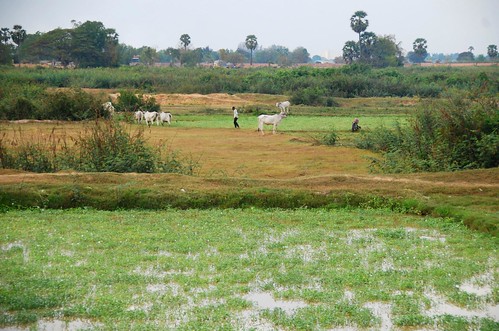
The Cambodian countryside near the Killing Fields.
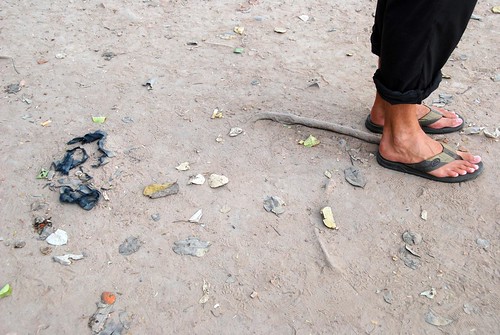
Bits of clothing still buried underfoot at the Killing Fields.
To sum it up, our experience of Cambodia was different than other parts of SE Asia because our feelings about it were never simple, like “I love this place!” or “I don’t really like this place.” More often our thoughts ran more along the lines of “I like this place but this part of it is disturbing to me” (Siem Reap), or “This place should really be challenging me but I am not reacting to it the way I should be and what does that say about me as an outsider?” (the Killing Fields). In other words, Cambodia was complicated. And I have to admit, I don’t think it should be any other way.
In general, I would say that SE Asia has been a challenge. Not in the literal way, because travel here is quite easy, but it’s just never what we expect. Each country we have visited so far on this trip teaches us something different about ourselves. In New Zealand, we were finding our groove, changing our routine and finding a new one in a different land. In Australia, I was learning how to find peace in an uncluttered day, getting accustomed to a life without endless to-do lists and never-ending projects (I realize this sounds silly, but it was a major change that took some getting used to). SE Asia has been all about never expecting one thing because then we will surely get the other. So thanks, Cambodia, for keeping us on our well-traveled toes.
Our next stop after KL was Siem Reap in Cambodia, a medium-sized town close to the Temples of Angkor. We (finally!) decided on a travel plan: we will travel through Cambodia, cross over to Vietnam in the south, eventually hitting Hanoi in the north, where we will cross over to Laos, and then travel to northern Thailand from there. At that point, we will either make our way back to Bangkok before heading to Malaysian Borneo to dive, or we will fly straight from Chang Mai in northern Thailand. It feels good to have a plan, even if it is a loose one, and we are still keeping our eyes and ears open for travel suggestions from friends and other travelers.
We flew from KL to Siem Reap for about 335 ringgit (approx. US$95) each (again, AirAsia). It was quite convenient because they issue visas right at the airport (US$20 per person) in Siem Reap. Immigration officials wanted payment in US dollars, and luckily, ATMs at the airport only dispense US dollars. We would come to find out that all of our financial transactions in Cambodia would be done in US currency, but they use Cambodian rials as “coins” (they are actually bills, but if you buy something that costs less than a dollar, you purchase it with rials). It works out quite well because the exchange rate is currently about US$1=1600 rials, so $0.25 is 400 rials. We tried to buy a bottle of water for $0.50 and I busted out some quarters that I had been carrying around since we left the States. The vendor looked quizzically at the quarters and then examined them like they were exotic gems: he had never seen US coins before.
On a recommendation from Jeremy’s friend Renee, we headed for Mandalay Inn (http://www.mandalayinn.com/), in the Psar Chaa area of town. We had read up about Siem Reap in the Lonely Planet before we arrived, but we couldn’t quite tell if this was a good area to stay; instead, LP listed three different areas to choose from. It soon became very apparent that backpackers wouldn’t really want to stay anywhere else in town but the Psar Chaa area—it is close to the restaurants, markets, and tuk-tuk drivers waiting to take you to the temples. Plus, Mandalay Inn was not only cheap (US$10 per night for a double with AC and private bathroom), but it was super clean, and it has free wi-fi, plus a beautiful, peaceful courtyard in the front. The staff was incredibly friendly and they went out of their way to make us comfortable. We found out that Siem Reap has a hospitality training program, and it was obvious that a lot of the people who worked at Mandalay Inn attended that school (often in a really cute way—after ordering our breakfast, the waiter would say “Now I am going to repeat your order back to you!” before he actually did it). Really, this may be the best place we stayed in all of SE Asia thus far, and one of the cheapest. We cannot recommend the place enough. Thanks for the rec, Renee!
We made our way to the temples that afternoon. We were originally planning on riding bikes from town to the temples, but when we realized that it was 14km away from town (AND we had gotten up at 3AM to catch our flight in KL), we decided to take a tuk-tuk. We literally were barely out of the hotel door when a driver approached us and offered a ride. We negotiated US$6 for the ride since we were only going for a half day, and we headed straight for Angkor Wat, the largest and most famous of the temples of Angkor. It did not disappoint.
The temples of Angkor were built as an act of spiritual devotion (first Hindu and then Buddhist), and they served as the capital of the ancient Khmer empire. Angkor Wat is the crown jewel of the temples; it is the largest spiritual building in the world. Cambodians are incredibly proud of this little piece of architecture (as they should be). We were blown away not just by the size but by the incredibly ornate carvings that cover the walls.
We were also lucky enough to catch a random Khmer dance performance in the center of the temple. The following photo might be one of my all-time faves!
Angkor Wat gets a lot of attention, but in reality, the surrounding temples are just as amazing, and each one is different in its own fascinating way. We bought a 3-day pass for US$40 each and spent our days leisurely exploring the park. There is Bayon, the temples with thousands of smiling, peaceful faces:
Preah Khan, the temple of hundreds of doorways, was one of my favorites. The doorways get bigger as you near the center of the structure, and apparently this is supposed to symbolize the unequal nature of Hinduism. As I was walking through this temple, however, I interpreted it differently: I saw it as the spirit inflating as you near the heart of the devotional structure, and the body slowly returning to its earthly form as you bend and duck to leave the temple grounds.
We were also really into Banteay Kdei, which was never completed. There was something really modernist and modular about the structure that appealed to both of us.
And, of course, we can’t forget Ta Prohm, where tree roots are oozing in and out of the buildings. Part of Tomb Raider was filmed here, which makes this temple the second most popular after Angkor Wat. By the way, we actually watched Tomb Raider while we were in Siem Reap…why not? ![]()
We watched a really nice “sunset” at Pre Rup. I put “sunset” in quotes because the sun never really sets—it just disappears into the layer of smog above the horizon. Still, it was a nice way to end the day and we met some nice people here too.
One place you might want to avoid for the sunset is Phnom Bakheng. We were taken there for our first sunset and while it’s a great place to watch the sun go down due to its setting on a hill, the crowds there make it a zoo.
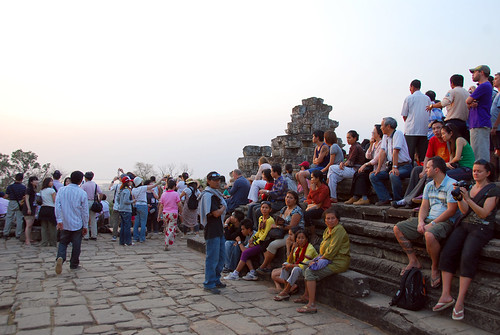
The peanut gallery waiting for the sun to go down.
Speaking of the sun, we did do the whole “Angkor-Wat-at-sunrise” thing. This is a very popular activity for tourists, so it’s not exactly the serene, spiritual experience you might desire. Just don’t expect to be alone out there (you won’t be). Still, it is beautiful, despite the 5AM wake-up time (ouch!).
In addition to the grandeur of the temples, the details are what really make the place come alive.
Yes, the temples are touristy. But unlike southern Thailand, we saw a lot more than European and American faces here. There are families that actually live near the temples and sell to the tourists that visit the park. On that note, let’s have a word about the children.
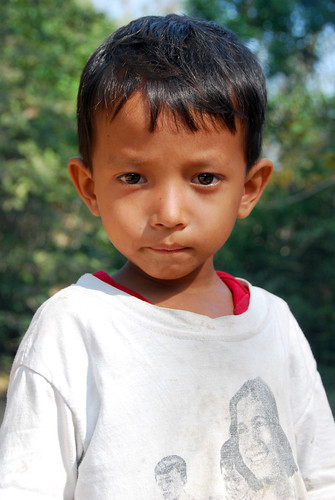
This little guy stared at me (just like this) until I shot this photo and showed him the screen. Then he broke out into the biggest, most beautiful smile.
Oh my, are they beautiful. But heartbreaking too, as each one is begging you to buy whatever they happen to be selling (cold drinks, bracelets, fresh fruit, wind pipes…wtf?). It’s hard because their families have sent them out to sell to tourists because they know it’s hard to say no to a child. But they should be in school and you don’t want to give them an economic incentive not to get an education. These are the extremes of Cambodia on display: poverty set amongst the beauty of the people and the magnificence of the temples. One of our tuk-tuk drivers told us that a person working for a company in Cambodia makes about US$30 a month, whereas a tuk-tuk driver can make US$10-15 a day. Plus, we have heard that corruption here is rampant, so any foreign money coming in to help eradicate poverty will inevitably line the pockets of many politicians before it reaches the people who really need it. Since we left Siem Reap, I have found myself wishing that we would have stayed longer, not only because we really liked the town, but also to have a chance to visit an orphanage or volunteer in some other way. Even though I regret not giving back to Cambodia beyond my US dollars, I’ve been inspired to keep my eyes open for opportunities that may come up as we get further along in this trip.
